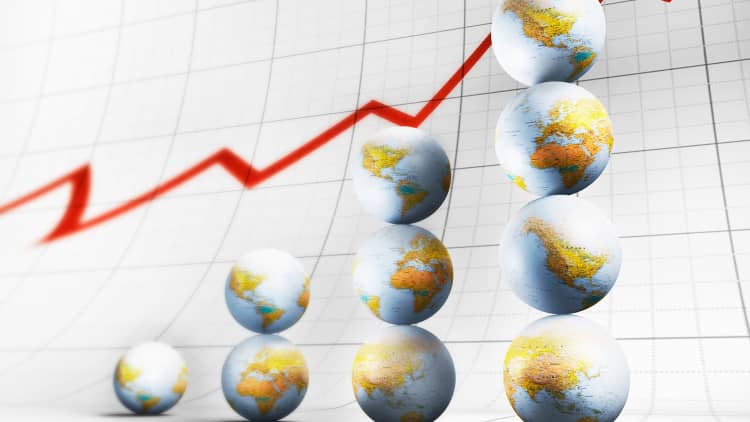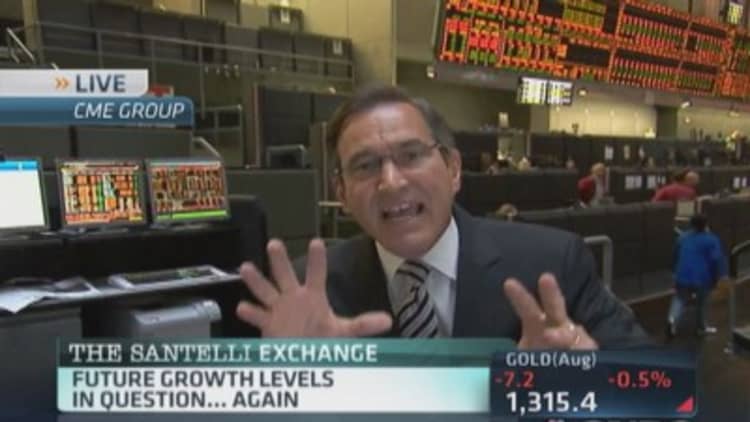
After a shocking contraction in , economists on Thursday pared back growth forecasts for the second quarter due to weaker consumer spending.
Consumer spending in May rose just 0.2 percent, half of what was expected, after being flat in April. Spending by consumers accounts for more than two-thirds of U.S. economic activity, and the lowered growth forecasts now raise concerns that the economy will not be able to rebound to the more than a 3 percent growth rate widely expected for the balance of the year.
Read MoreJobless claims dip, spending weaker than expected
Goldman Sachs economists trimmed second quarter tracking GDP to 3.5 percent from 4.1 percent, and Barclays economists said tracking GDP for the second quarter fell to 2.9 percent from 4 percent. At a pace below 3 percent, the economy could show contraction for the first half due to the steep first quarter decline of 2.9 percent.
The median estimate for second quarter GDP fell by a half percent to 3 percent, according to the CNBC Rapid Update of economists forecasts.

"We already know that retail sales haven't looked great. This reflects that. This just looks like a pretty restrained path of consumer spending," said Michael Feroli, chief U.S. economist at J.P. Morgan. Feroli said he is maintaining his forecast for 3 percent second quarter growth for now, but the disappointing consumption number puts it at risk.
"The expansion has been about a 2 percent expansion, and it kind of feels like it's continuing," he said. "We're still maintaining a little hope it gets better in the second half." He said the economy does feel like it's turning around from the first quarter's slump, blamed in large part on bad winter weather.
Read MoreThis report better show consumers stepping up
The weaker outlook for the second quarter is particularly difficult since some economists on Wednesday upped their outlooks based on the fact that some of the missing spending could roll into the second quarter and growth could bounce back.
But that is now seen as less likely, and also in doubt is whether the economy will run on the full head of steam expected for the second half of the year.
"Turning around, as in escape velocity, doesn't seem a plausible outcome," Feroli said.
"It's everything we're seeing now calls it into question. It's not the particularities of this number or that. It's just the overall economy," he said. "When it's moving along, at what pace is it moving along, even without impediments ... it's a little bit of an uphill."
The first quarter decline was the worst drop since the Great Recession, and was based largely on a steep downward revision in health-care spending and a reduction in exports. Reduced health-care spending could also be the culprit in the second quarter, since real spending on services declined by 0.2 percent.
Read MoreWhy Obamacare will suck the life out of the economy
"The available data on healthcare spending in Q2 has not been consistent with the way we assumed the Commerce Department would continue to account for the Affordable Care Act, which would have resulted in a boost to growth," Goldman economists wrote.
In the first quarter revision, the contribution from consumption went from 2.1 percent to 0.7 percent, and within that number health care was a large drag. The initial estimate in first quarter GDP was a positive 1 percent for health-care services but that fell to a decline of 0.2 percent.
Read MoreNew GDP outlook: Moderate, not rosy
The government had initially estimated a big increase for health-care outlays under the assumption that many individuals had signed up for coverage under the Affordable Care Act. Barclays noted that the main cause of the downward revision was in medical services consumption, reduced from a 9.1 percent annualized growth rate to a 1.4 percent annualized contraction.
Feroli said the Bureau of Economic Analysis had assumed modest increases in real outlays for health care in April and May, but the hard data for the first quarter indicated a decline that could be from two factors. One is that there could be payback for some extra 2013 spending on elective care before changes at the beginning of the year, and a milder-than-normal flu season, resulting in fewer hospital stays.
Read MoreCheerup, things can only get better: Fed's Bullard
"Beginning with Q2, we should probably expect to see less volatile swings in health-care spending—either real or measured—than has occurred in the prior two years," Feroli noted.
Consumers did buy cars in May, and real spending on durables rose by 1 percent. Nominal income rose 0.4 percent in May, and core personal consumption expentiture prices rose 0.2 percent as expected.
2014 is now setting up to be a year of moderate growth, not the rosy rebound many economists expected. Second quarter growth, expected at about 3 percent, meaning that the first half of 2014 could show no growth at all. Expectations are for higher growth rates of 3 percent or more for the third and fourth quarter. That would still mean growth for the year could be just about 2 percent or less.
—By CNBC's Patti Domm.


